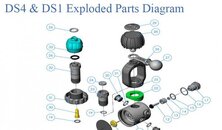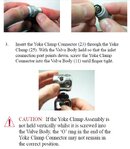gcarter
Contributor
Apeks ATX40 / DS4 regs, yoke.
Gearing up for a dive yesterday afternoon, I was talking to someone while unscrewing the thumbwheel to remove the ball from the yoke in preparation for mounting it on my tank. When I released the thumbwheel to reposition my fingers for another twist, the yoke connector dropped out of the first stage to the ground. Whoops. In turning the thumbwheel, I had inadvertantly uncrewed the yoke connector from the first stage. It was apparently a bit loose.
I retreived the yoke clamp and spacer, cleaned it off, and reassembled, ensuring it was properly snugged down.
No leaks were evident (no hissing, no bubbles), either on the surface or in the water.
Nonetheless, over the course of ~ 10 minutes, my HP100 bled off ~ 100psi. I chose to proceed with the dive anyway, as it had a max depth of only 45' with an average depth of 25'. I had done this dive before, and it was within easy striking distance of the shore (drift dive in the St Lawrence) so I was comfortable that the risk was low / manageable. I was also diving with a reliable buddy with whom I have done the majority of my diving, and we agreed that we were ok with the issue.
The dive was uneventful, and I had sufficient air to complete with 500 psi remaining.
Upon returning home, I dug out the parts diagram for the DS4. As it turns out, there is an o-ring that belongs at the end of the connector that holds the yoke clamp in place. This o-ring (and its lack) was not evident to me when I reassembled my first stage at the dive site.
I feel fairly safe in assuming that this missing o-ring was the cause of the pressure loss, yet do not understand why the leak resulted in neither hissing nor bubbles.
In any case, I am compelled to ask the question as to what the risk of first stage failure was without the o-ring in place.
Gearing up for a dive yesterday afternoon, I was talking to someone while unscrewing the thumbwheel to remove the ball from the yoke in preparation for mounting it on my tank. When I released the thumbwheel to reposition my fingers for another twist, the yoke connector dropped out of the first stage to the ground. Whoops. In turning the thumbwheel, I had inadvertantly uncrewed the yoke connector from the first stage. It was apparently a bit loose.
I retreived the yoke clamp and spacer, cleaned it off, and reassembled, ensuring it was properly snugged down.
No leaks were evident (no hissing, no bubbles), either on the surface or in the water.
Nonetheless, over the course of ~ 10 minutes, my HP100 bled off ~ 100psi. I chose to proceed with the dive anyway, as it had a max depth of only 45' with an average depth of 25'. I had done this dive before, and it was within easy striking distance of the shore (drift dive in the St Lawrence) so I was comfortable that the risk was low / manageable. I was also diving with a reliable buddy with whom I have done the majority of my diving, and we agreed that we were ok with the issue.
The dive was uneventful, and I had sufficient air to complete with 500 psi remaining.
Upon returning home, I dug out the parts diagram for the DS4. As it turns out, there is an o-ring that belongs at the end of the connector that holds the yoke clamp in place. This o-ring (and its lack) was not evident to me when I reassembled my first stage at the dive site.
I feel fairly safe in assuming that this missing o-ring was the cause of the pressure loss, yet do not understand why the leak resulted in neither hissing nor bubbles.
In any case, I am compelled to ask the question as to what the risk of first stage failure was without the o-ring in place.





